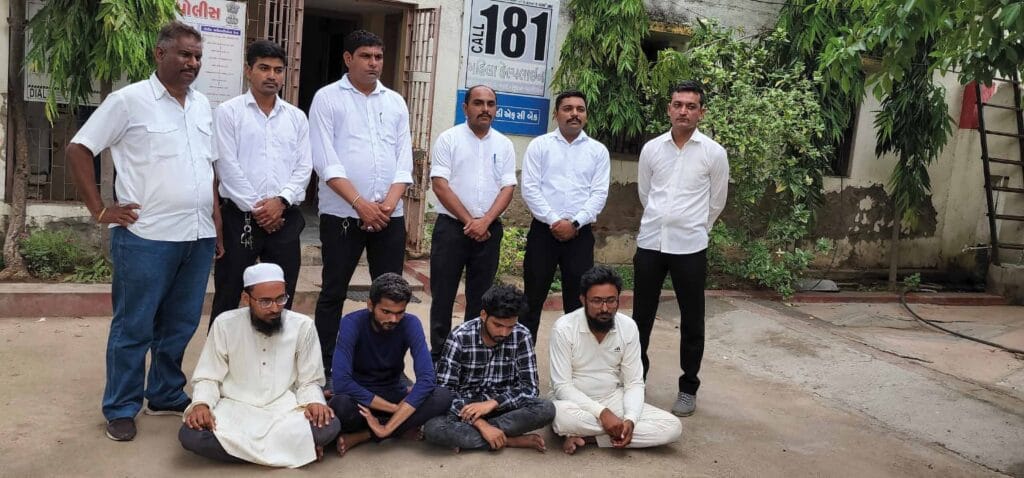Sixes, lies and videotape
In July 2022 the uncovering of a series of rigged cricket matches imitating the Indian Premier League made headlines worldwide. They seemed to be part of an inelegant scam aimed at gullible Russian punters incapable of telling the difference between these amateurish knockabouts and the richest cricket tournament in the world – but could there be more to the fake games than meets the eye?

Stills from the livestream of the ‘Century Hitters T20’ tournament show a player answering his mobile phone mid-over
11th July 2022 (Taken from: #48)
At first glance the video seems to be of a professional cricket match being played in India, home of the Indian Premier League (IPL), the world’s richest cricket tournament. The teams are named the Maharashtra Rangers and the Palanpur Sports Kings and their players’ IPL-esque uniforms – the Rangers in bright red, the Kings in even brighter pink – stand out against a dusty field. The graphics on the bottom of the screen not only display the score, but who’s at the crease, the run rate and the projected result.
But on closer inspection some incongruous details can be seen: the pitch is pockmarked and shabby, orange traffic cones stand in for crease lines and the Kings’ bowler has just paused mid-over to answer his mobile phone. Having completed his call he slips his phone back into his pocket and proceeds to bowl another halfhearted delivery. Nobody bats an eyelid. The video continues. The batsman hits a shot but the camera does not move and there’s no way to tell where the ball went, whether it was caught or crossed the boundary. But the onscreen scoreboard changes: it’s a four. It’s evident, even to an untrained eye, that something’s not right. But 5,000km away, Russian punters are apparently placing bets on the match – billed as the quarter final of the plausibly-named ‘Century Hitters T20’ tournament – through a Telegram channel. It later emerges that at least 300,000 rupees (more than £3,000) have been staked on the outcome.
Later the same day, 7th July 2022, another cricket match, Chennai Fighters vs Gandhinagar Challengers, takes place on the same field. In one of the more impressive moments of the tournament, batsman Hasan Ali hits a drive. Again the camera stays on the pitch as the ball zooms out of sight. This time, however, something else is happening outside the frame. Everybody on the field is looking at it. The umpire stiffens and walks away nervously, holding his walkie talkie to his mouth. At the bottom of the screen, behind the digital scorecard, a man in a different sort of uniform appears and runs towards the players. It’s a police raid. The field empties. The video cuts to black.
The Indian media called it the “fake IPL” scam – a series of bogus matches involving a group of labourers and farm workers in Mehsana, a district in the state of Gujarat, with a director telling the umpire and players via walkie talkie what should happen next, apparently in order to maximise profits from Russian punters gambling on the outcome. All kinds of rumours were reported: that “fake IPL” teams were named after the real IPL leagues (they weren’t, although they were named after major cities as in the IPL), that the scammers roped in someone to imitate Harsha Bhogle, the IPL’s famous commentator (they did, the real Bhogle tweeted his amusement upon hearing the news) and that semi-professional cricket players had been co-opted to coach the teams (apparently true, despite the dismal quality of the cricket that resulted).

Composite image by Miller Webb
Before the police raid the bogus tournament was streamed live on YouTube and footage of the games was still available until November 2022 when all videos were deleted. Other highlights of the coverage included a bowler in sunglasses, a fielder in shorts, an umpire in sandals and a forgotten helmet stranded on the pitch during play. In one game a batsman, having been bowled out, the middle stump knocked clean over, picks up the ball, throws it back to the bowler, fixes the wickets with help of the fielders, and resumes batting. “Nobody who [really knows] the game can be fooled by this,” Achal Tyagi, the superintendent of police in Mehsana who investigated the bogus games, says. “[But] if you [glance] at the video footage… [it might] give you the impression that some [legitimate] match is happening.” And sometimes that impression is all you need.
Just not cricket
Ronan O’Laoire is a crime prevention and criminal justice officer working in the United Nations office on drugs and crime (UNODC), where he leads the programme on safeguarding sport from corruption. He doubts anyone was really paying attention to the games being streamed from Gujarat. “I think it’s highly unlikely that this is aimed at some fan in Russia who has no idea of what they are watching,” he says. “I think there’s something bigger going on.”
O’Laoire was responsible for the coordination and substantive development of UNODC’s global report on corruption in sport, which reveals “the staggering scale, manifestation, and complexity of corruption and criminal networks in sport at international and national levels.” The machinations of organised crime are a longstanding threat to the integrity of sport, but O’Laoire believes that until recently there has been a reluctance for either sporting organisations or the criminal justice system to take action against them. “Corruption and crime weren’t really seen as problems that sports organisations fundamentally saw as their sole responsibility to address – they believed that the ministries of justice and the police should take the lead,” he says. “And often these public authorities saw it as sport’s problem to fix.”
O’Laoire views his team’s role at the UN as bringing the parties together to take action – and he believes that they are having some success. “Since 2015, when we saw the arrest of Fifa officials on corruption charges, we have seen a paradigm shift in the engagement of governments and the perception of what the problems are in sport,” he says. “We’re trying to create the mechanisms for criminal justice authorities and sports authorities to talk to each other more to address some of the vulnerabilities.”
Those vulnerabilities include the influence of illegal betting, which encompasses everything from an individual in a country where gambling is banned placing bets through an unlicensed bookie, to international scams such as the fake IPL games. O’Laoire says that it’s hard to overestimate the scale of illegal betting, with his report estimating that the black market accounts for as much as 80 percent of the total money bet on sports worldwide. “The sums of money are absolutely huge,” he says. “We’re talking about hundreds of billions of dollars being illegally wagered, probably into the trillions. Add in the links to money laundering, exploitation and organised crime and the scale of it is frankly unknown.”
It is money laundering that could, O’Laoire speculates, be behind the Century Hitters tournament – with legitimate bookmakers manipulated into inadvertently helping. “If betting companies can be convinced the game is on and offer it as a product to their customers, the organisers of the rigged games are then free to gamble on it knowing the outcome,” he says. “Imagine a drug trafficker who has made a million through their illicit activities and they need to hide it. They could buy a hotel or a restaurant, but it’s complicated and it could cost them 20 percent of their illicit gains to clean their money. But with match-fixing all they need is a betting slip. Their betting slip shows that they won their money and it can be shown to the tax authorities.”
O’Laoire is keen to stress that this is only a theory, but it does make sense. If a legitimate site takes bets on a controlled match then criminals have an easy route to ‘clean’ money. Any cash made from naive gamblers betting directly on services like Telegram would be a bonus, but would be unlikely to warrant the effort on its own.
But how do you get the game onto the betting sites? That’s where technology comes in. Digitisation has driven gambling into the mainstream in recent years. According to data from betting analysts H2 Gambling Capital, in 2007 – the year Apple released its first iPhone – the total amount legally staked on sports worldwide was an estimated $217 billion, and by 2021 that number had nearly tripled to $626 billion. “I grew up in Dublin. If I wanted to place a bet I’d have to walk into a shop, which had fixed opening hours, and show that I was 18,” says O’Laoire. “Now I just need a smartphone and a credit card and I can start betting at any time of day or night.”
Data has caused an explosion in the number of things you can bet on”
O’Laoire says that the globalisation of gambling through new technology became starkly apparent during the Covid-19 lockdowns. “Nearly all of the football leagues around the world basically shut down except for a few exceptions, including Belarus and Honduras, and what was of interest to many was the high number of gamblers betting on those games, in particular punters based in Asia,” he says. “It raises a question about the scale of gambling addiction when gamblers in Asia are betting on games in Belarus about which they ostensibly have very limited knowledge. It suggests that this is less about having a flutter on a team that you follow, and more about sport being used as a vehicle to deliver the gambler’s fix.”
The app-driven digitisation of sport has also expanded the options for bookmakers. “Alongside the number of international games someone can wager on, digitisation has caused an explosion in the number of things you can bet on,” O’Laoire continues. “How many yellow cards in a football game, how many no balls in a cricket match, who’s going to get the next goal, the next wicket, the next six.” Rather than having someone calculate the odds of all these possibilities, the more sophisticated bookmakers often use their own machine-learning algorithms to generate the odds before and during each match.
However while technology brings new opportunities to gambling sites, it also makes them more vulnerable to scams. As well as being available on YouTube, all the games from the Century Hitters T20 tournament were documented on CricHeroes, billed as the “World’s #1 free cricket scoring app”. Here it is much harder to spot the difference between the bogus knockabouts and a professional match. There’s ball-by-ball text commentary, a plethora of statistics, often presented as infographics, and player of the match awards.
The statistics of the Maharashtra Rangers vs Palanpur Sports Kings match make for interesting reading. Having failed to score a single run in the tenth over, the Kings hit an unlikely 28 in the eleventh. The data is slickly presented, easily accessible and free for gambling sites to input into their own systems and drive their odds calculations should they wish. If you can persuade at least one online gambling site to take your staged game seriously – and at least one site was offering odds on the July Rangers vs Kings match – you can set about using it to clean your ill-gotten gains.
Compared to other money laundering schemes, using rigged matches and real betting sites seems like a low risk and lucrative option. “What does it cost the match-fixer?” asks O’Laoire. “They have mules laying bets across the country, sometimes across the world. They can bribe the referee or the players a few thousand dollars to throw a game. Or, in the case of these fake cricket games in India, they can stage the whole thing.”
Caught out
Just four people have been arrested over the fake IPL tournament – brothers Shoeb and Sadiq Davda and the umpires, Mohammed Kolu and Saqib Mahamad. The key man appears to be 27-year-old Shoeb Davda. Earlier in 2022 he had returned to his hometown of Molipur in Mehsana, after eight months in Russia. Before travelling to Moscow, he had spent years trying to make ends meet and support his family – he worked as an electrician, he reared buffaloes, he waited tables in Mumbai restaurants, he returned to farming. The village headman, Ismailbhai Dhaniya, the only person in Molipur willing to speak to the media, told journalists that Davda was a hard worker who eventually had to sell a small plot of land to move abroad in search of work. Davda had hoped to go to the Gulf but passport agents convinced him that there were better opportunities in Russia.

Police officers in Mehsana stand over Mohammed Kolu, Shoeb Davda, Sadiq Davda and Saqib Mahamad, the four people arrested in connection with organising the fake tournament
Davda’s lawyer Raybhanji Thakur says that while his client – who along with the three other defendants has pleaded guilty to all charges relating to the fake tournament – was in Russia a fellow cricket fan told him that he could earn a regular and sizable income by organising matches back in India. Police believe that the tournament was orchestrated by a Russian kingpin so far only identified as ‘Efimov.’ One of his Indian aides allegedly handled the operations.
According to Thakur, Efimov transferred 300,000 rupees to Davda through middlemen. Most of it went on expenses. Davda rented an empty stretch of farmland for 20,000 rupees (around £200). He bought some equipment – bats, stumps, cricket balls (the players had only ever used tennis balls before), helmets, pads and gloves. He rented several sets of jerseys for different teams. “There are about 3,000 houses in Molipur but no one has a television,” says Thakur. Meanwhile in a small shed he had built in the corner of the field Davda set up a comparatively hi-tech operation featuring generators, wi-fi routers and laptops. He strapped halogen lights to bamboo poles for night-time matches and set up speakers through which he played recordings downloaded from the internet of cheering crowds. And he held auditions. About 70 people, mostly farmers and labourers, from in and around Molipur showed up and 20 were selected. For every match they played, Davda gave them 400 rupees (about £4) each, higher than the average daily wage in the region. Snacks were provided. In the shed, Shoeb and Sadiq would manipulate the match in real time, instructing the umpires, Kolu and Mahamad, via walkie talkie to signal runs, penalties and wickets. It all worked out well for nine matches over three weeks. And then, on 6th July, the police got a tip-off.
The organisers in Russia realised that they cannot hold matches only in one place”
There are different theories about who blew the whistle. Some news sources reported that a few semi-professional players were brought in from local cricket academies and were upset about the game being disrespected. Others pin it on caste. Molipur is a Muslim-dominated village, but Davda had selected players from other communities in neighbouring villages. According to this line of thought, a few upper-caste Hindu players were apparently offended at being dismissed in the fixed matches despite playing well and reported the organisers. Thakur, who is representing all four defendants, claims that none of the players were in on the scam.
The police don’t see the players as innocent victims, however, and Superintendent Tyagi says it is likely they knew what was taking place. “Of course [they knew what was happening],” he says. “They were all paid at the end of every match. They may not have been operating the scam but it is a collusion nevertheless.” Despite this belief, so far the police have only listed the players as witnesses rather than charging them with any crime.
Gujarat could have been just the beginning. It seems that the plan was to spread the scam to other cities and sports: on the Century Hitters T20 channel, a couple of less than professional-looking volleyball matches warrant a closer look. “The organisers in Russia realised that they cannot hold matches only in one place, it becomes risky,” says Tyagi. “People may find out, police may take action, it may rain.” Tyagi believes that the scammers needed to expand “so that come what may, they would have something to show, some match going on somewhere,” he says.
Bookies only watch five minutes of the match to see that, yes, they are playing. After that, they just follow the score online”
A few days after the Gujarat police raid, officers 800 miles to the north discovered another bogus tournament held in stadiums across Meerut and Hapur. Named after a region miles from where the games were being played, Big Bash Punjab T20 looked more professional than the Gujarat gambit, with more impressive production values, grounds and players. Once again the matches were streamed on YouTube and bets were taken on the games via gambling apps. Police believe that both the Gujarat and Meerut-Hapur games were orchestrated by the mysterious Efimov and run by his Indian aide, who allegedly set up a cricket training academy in Meerut before moving to Russia. Superintendent of police in Hapur, Deepak Bhuker, believes the point of the videos is to hoodwink bookmakers into offering bets on the matches. “Bookies only watch five minutes of the match to see that, yes, they are playing. After that, they just follow the score [online],” he says.
Pushing boundaries
While the app-driven digitisation of sport has created room for corruption, UNODC’s O’Laoire believes that data could also help provide a solution. “The use of technology to detect wrongdoing in sport is growing,” he says. “That can be measuring the performances of athletes to see if they are suddenly dramatically underperforming [to throw a game], but can also include analysing data to identify weird betting patterns which might suggest there are suspect things going on.” In the future, AI could monitor online sport and gambling and filter out scams as they happen.
However O’Laoire believes that until a coordinated approach and stricter punishments are enforced, criminals will still see sports betting as an attractive way to launder money. “It’s a low-risk activity,” he says. “Are existing laws enough to put people in jail? Are there people with the knowledge, the contacts, to be able to run an investigation into these sorts of problems? With these fake Indian Premiere League games, it is very difficult to know how much money was made or laundered and we’ll probably never know”.
In the case of the Century Hitters T20 matches, it seems that the consequences for the perpetrators have so far been minor. All the accused have been released on bail after spending two days in remand. They’ve been charged with cheating and gambling, which could land them in jail for seven years, but their lawyer thinks it unlikely. “There aren’t too many charges,” says Thakur. “They will be let off.” Thakur says he was even able to get a court order to have Davda’s confiscated tournament equipment returned to him by the police within weeks. According to a source in Mehsana, he has begun organising cricket matches again.
While not commenting directly on those accused in the fake IPL case, O’Laoire believes it is imperative that the integrity of sport is upheld. “Sport taps into our values,” he says. “Many of us are brought up on the football pitch, on the cricket ground. That’s where you learn how to win and lose, how to share, how to cooperate. The values sport transmits to people are so important and we’re seeing it being abused for illicit gain. It needs to be protected.”
Slow Journalism in your inbox, plus infographics, offers and more: sign up for the free DG newsletter. Sign me up
Thanks for signing up.








